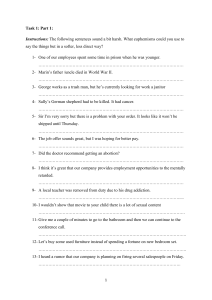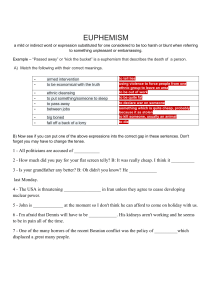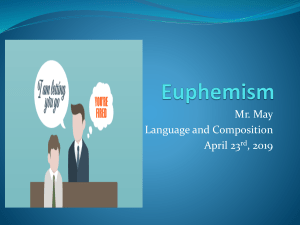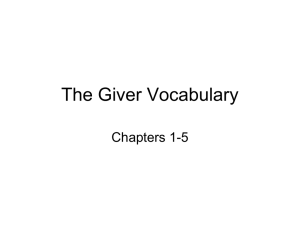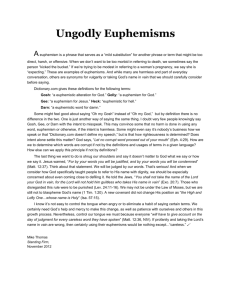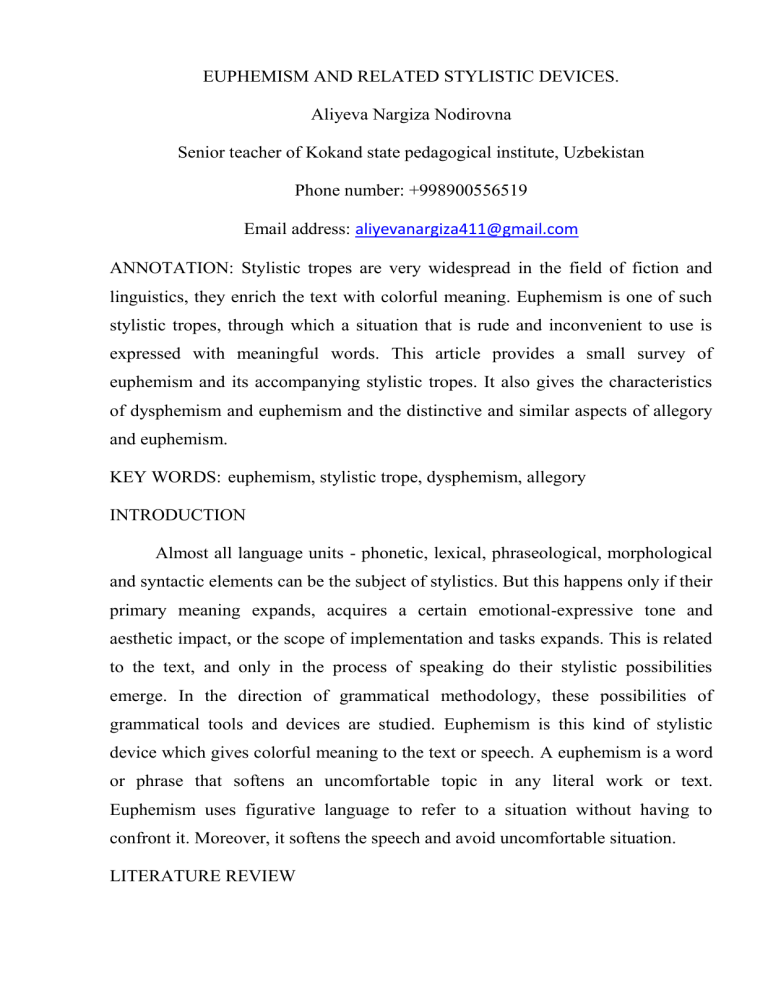
EUPHEMISM AND RELATED STYLISTIC DEVICES. Aliyeva Nargiza Nodirovna Senior teacher of Kokand state pedagogical institute, Uzbekistan Phone number: +998900556519 Email address: aliyevanargiza411@gmail.com ANNOTATION: Stylistic tropes are very widespread in the field of fiction and linguistics, they enrich the text with colorful meaning. Euphemism is one of such stylistic tropes, through which a situation that is rude and inconvenient to use is expressed with meaningful words. This article provides a small survey of euphemism and its accompanying stylistic tropes. It also gives the characteristics of dysphemism and euphemism and the distinctive and similar aspects of allegory and euphemism. KEY WORDS: euphemism, stylistic trope, dysphemism, allegory INTRODUCTION Almost all language units - phonetic, lexical, phraseological, morphological and syntactic elements can be the subject of stylistics. But this happens only if their primary meaning expands, acquires a certain emotional-expressive tone and aesthetic impact, or the scope of implementation and tasks expands. This is related to the text, and only in the process of speaking do their stylistic possibilities emerge. In the direction of grammatical methodology, these possibilities of grammatical tools and devices are studied. Euphemism is this kind of stylistic device which gives colorful meaning to the text or speech. A euphemism is a word or phrase that softens an uncomfortable topic in any literal work or text. Euphemism uses figurative language to refer to a situation without having to confront it. Moreover, it softens the speech and avoid uncomfortable situation. LITERATURE REVIEW Going to the back history, euphemism has been learning for a long time. The word “euphemism” can be traced back for the first time in a book written in 1656 by Thomas Blount, Glossographia [Burchfield 1985: 13], and comes from Greek word “euphèmismos”, which is itself derived from the adjective “euphèmos” which means “of good omen” (from eu, “good”, and phèmi, “I say”) that is “I say good words”. Euphemisms first appeared in works of art in ancient Greek literature, mainly in folklore. In Uzbek linguistics, dealing with the issues of grammatical stylistics came to the field directly as a continuation of the research on the stylistics of the Uzbek language. It belongs to R. Q. Kungurov. The views of the scientist in this field range from large and small scientific articles to “O‘zbek tili stilistikasidan ocherklar” ( “Essays on the Stylistics of the Uzbek Language”) (Samarkand, 1975), (“O‘zbek tili grammatikasi”ning akademik nashri) the academic edition of “The Grammar of the Uzbek Language” (Tashkent, 1975), “Стилистика имени существительного в узбекском языке” (Tashkent, 1983). ), co-authored “O‘zbek tili stilistikasi” (“Uzbek Language Stylistics”) (Tashkent, 1983), and many other masterpieces were contributed by great Uzbek linguists as well as scientists. MATERIALS AND METHODS The linguists who have analyzed the scope of contemporary stylistics emphasize that it has four directions, such as linguistic stylistics or visual stylistics, functional-task stylistics, individual speech stylistics, external or comparative stylistics, and define the research object, goals and tasks of each of them. Euphemism is also an integral part of stylistics, and as we mentioned above, any rude text can be conveyed through it in a sincere manner. A euphemism is a word or phrase used to replace a word that has a socially offensive or negative connotation. They can be used to replace all kinds of terms, for example, to turn a bad situation into a good one by replacing it with words that might be rude or obscene. Euphemisms are usually used to replace as the following Offensive terms that may cause discomfort to a group of people. Often something is 'politically correct' to express that something is socially accepted or favored by society. For example, “Senior citizen” (old people). Harsh and unpleasant words that can cause discomfort. Some of the euphemisms used in these situations can be used in a humorous way, used to soften the truth they are replacing. Harsh and unpleasant words that can cause discomfort. Some of the euphemisms used in these situations can be used in a funny way to soften the reality they are replacing, for example, “stretch a leg” in Uzbek, “kich the basket ” in English (to die) or simply “where the cucumber is bitter” (ass) to provoke laughter. Together with the word euphemism, the term dysphemism is also widely used in linguistics. Euphemisms are stylistic tropes that are used to express resentment, sarcasm, criticism, or to replace harsh words with better ones. We can cite many stylistic devices and tropes such as metaphor, metonymy, synechdoxy, allegory, irony, etc., which are similar to this stylistic device or antonymous to it. As a stylistic device euphemisms have the same patterns as it is in linguistics. Because all stylistic tools are tools that show the writer's own style and vocabulary in artistic literature. RESEARCH AND DISCUSSION As we mentioned above, these are the words that appear as synonyms of words and expressions that seem uncomfortable, inappropriate or rude to the speaker, and they serve to avoid calling negative reality, to mitigate the negative impact of such reality, and which affect a person's dignity. to reduce the negative impact of situations that are embarrassing, disrespectful, contrary to moral standards or secret realities that cannot be directly stated, to hide and cover them; it is used to convey and express an unpleasant message in a gentler, gentler way. In my opinion, the closest stylistic trope to euphemism is allegory. Because in allegory there is a characteristic used in fiction, through which people can be criticized. Of course, this stylistic trope is used as a euphemism to avoid rudeness. allegory is also a specific stylistic trope in which animals and inanimate objects are expressed by animating or adding human characteristics to them. The works of art where allegory is used mainly belong to folklore. However, we can see writers and poets making good use of allegory in fiction. One can see the colorfulness of allegory in the folk tales “Ur Tuqmoq” and “Zumrad va Kimmat”. euphemism is also used in these fairy tales, for example, in the fairy tale “Ur tuqmoq”, the old man beating a lying merchant with a stick without insulting him is an example of the compatibility of euphemism and allegory. In addition, there is a concept of dysphemism along with the concept of euphemism in linguistics. Dysphemism is the opposite of euphemism. It is a type of irony that consists of using negative or pejorative expressions to describe things, events, or people. Both euphemism and dysphemism are specific types of metaphors, usually studied in discourse analysis. Euphemisms retain their usual meaning in addition to the meaning given to them when used in place of other terms. Therefore, they can be misleading in certain situations. CONCLUSION As a conclusion some features of euphemisms are given here: First and foremost importantly, euphemism cannot be replaced by any other word in a way that fully preserves the same cognitive, methodological and social effects. This happens because there are almost no strict and absolute synonyms in Spanish. Secondly, a word can act as a euphemism, if its interpretation is unclear on the part of the listener, he interprets it literally or euphemistically. Coming to the third, when a euphemism is used widely, it is more like a synonym than a euphemism. Last but not least, euphemisms can only be defined in the context in which they are uttered, and their understanding depends on several factors, including the knowledge, social practices and beliefs of the interlocutors involved in the linguistic exchange. So euphemisms are vitally important in both communication and literature in the same degree. REFERENCEES: 1. Ad.\ Shomaqsudov A., Rasulov I., Qoʻngʻurov R., Rustamov H., Oʻzbek tili stilistikasi, T., 1983; Omonturdiyev A., Oʻzbek nutqining evfemik asoslari, T., 2000. Neʼmat Mahkamov. 2. Ismatullaev N. Evfemizmi v sovremennom uzbekskom yazike: Avtoref.…kand.filol.nauk. -T., 1963. – 19 s. 3. Krisin L.P. Evfemizmi v sovremennoy russkoy rechi [Elektronniy resurs]. – Rejim dostupa: 4. Ismatova, N., Alieva, N., Djalilov, R., & Abdisamatov, A. (2020). THE PROBLEMS OF TRANSLATING SOME PHRASAL VERBS FROM ENGLISH INTO UZBEK. Theoretical & Applied Science, (1), 760-768. 5. Nodirovna, A. N. (2022). SOME FEATURES OF EUPHEMISMS IN LITERAL TEXTS. Open Access Repository, 8(11), 139-141.
